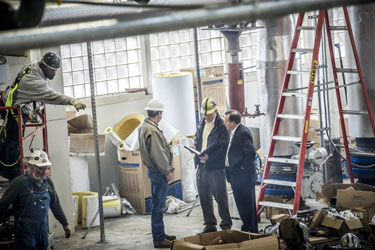 |
| Leaders of the project include (from left) Ty Quarles, Brooks Baker, James Gilliam, Joe Grice, Matt Winslett, Olen Pruitt, Pittman Owen and Buddy Cope. |
|
Did you know? The water that is saved in the condensate return is at a temperature of 160 degrees. It is then combined with additional water and heated to 220 degrees, after which it goes into the boiler — which heats it up to approximately 440 degrees to make the steam. |
Water, chemicals and energy were cheap when Alabama Power Company constructed its Powell Avenue steam plant more than 60 years ago. So, the capture of hot condensate left over from the steam generated by the coal-fire plant and return of it to the boiler for re-use likely wasn’t a consideration at the drawing table.
“It probably didn’t make the economic sense to do condensate recovery back then,” says Jim James, assistant vice president for Planning, Design & Construction. “It was cheaper to throw away the watered chemicals and thermal energy. But time has a way of changing things — both in terms of the way you think, and the economic aspect.”
That’s why when UAB’s District System Steam Project begins full operations this month, a condensate return system will be in place. And it will far surpass the energy efficiency of the old Powell Avenue steam plant, the closure of which Alabama Power announced five years ago. That move necessitated the construction of the $72 million UAB steam system, which was approved by The University of Alabama System Board of Trustees in June 2010.
The new steam-generation plant, which is natural gas-powered, is located at the corner of Sixth Avenue South and 13th Street, across from Bartow Arena.
Many UAB buildings use steam for heating, sterilization and humidification, but the decision to build an on-campus steam plant certainly didn’t happen on a whim. UAB commissioned several studies on what it should do to replace the Powell Avenue plant. In the end, says James, there were more than 30 different options. Among those available were installing individual boilers in each of the affected buildings, constructing five or six miniature steam plants in strategic locations on campus, and/or converting some of the buildings to hot water instead.
 |
| UAB's District System Steam plant contains four boilers, each one like the one above. |
James says those evaluating how to go forward even discussed cogeneration, which is when a heat engine or power station is used simultaneously to generate both electricity and useful heat (think of making your own electricity cheaper than you could buy it). None of those were the most cost-effective — or most practical — choice.
“We spent two years analyzing options and ways to proceed,” James says. “At the end of the day, constructing our own steam plant was the best way to do it for many reasons.”
Condensate return
One of the key reasons for this is the condensate return system, which is an attractive method of improving power plant efficiency because it increases the condensate return to the boiler.
When steam transfers its heat in a manufacturing process, heat exchanger or heating coil, it reverts to a liquid phase called condensate. As more condensate is returned to the boiler, less make-up water is required, which saves fuel, make-up water, chemicals and treatment costs. Less condensate discharged into a sewer system also reduces disposal costs. And the return of high-purity condensate also reduces energy losses due to boiler blow down. It’s clean and green, especially with the natural gas component added in.
|
By the numbers • $72 million: The total cost of the District System Steam Project • 160 degrees F: The temperature of the water that will be captured by the condensate recovery • 50 million: The number of gallons of water UAB will save annually with the condensate return • $4,000-$4,400: The cost of 1 million gallons of water • 20,000: The linear feet of piping used on the project — the equivalent of almost four miles • 3-20 feet: The range of the depth of the steam pipe throughout the project • 35 percent: The overall amount of steam to the campus that the steam plant will provide • 29: The number of UAB buildings connected to the steam plant lines |
“The old Powell Avenue site had coal shakers, so going to natural gas is a great improvement for the environment,” says Matt Winslett, engineering manager in the Energy Management Department. “Add the condensate return and you’ve reduced your greenhouse gases by another step, which is a big plus for air quality. The boiler manufacturer guarantees 80 percent efficiency.”
“This is state-of-the-art combustion controls,” James says. “It’s one of the nicest systems out there.”
The condensate return should result in significant fuel savings, too.
Most returned condensate is relatively hot (160 degrees F), reducing the amount of cold makeup water (70 degrees F) that must be reheated.
“Our research indicates that we will see anywhere from 10 to 20 percent energy savings depending on how much condensate we get back,” Winslett says. “All of that water that we would normally get back at 70 degrees will come back at 160, which means all of that energy to raise tap water all the way up to 160 we will get back for free. We also should save at least 50 percent on water treatment cost, because the water you bring in from the domestic source has to be treated before you boil it to save wear and tear on your equipment. The condensate we get back already will have been treated.”
Obviously, another savings component of the return system is the amount of water used annually.
“The return system should save more than 50 million gallons of water per year — easily,” says Pittman Owen, a boiler consultant and professional mechanical engineer who has worked with UAB on the project.
 |
| The flames inside the boiler heat water to approximately 440 degrees to make steam. |
“A millions gallons of water is worth about $4,000-$4,400 right now without sewer,” Winslett says. “We use about a million gallons a week, and we won’t have to pay sewer on the condensate return. That should add up to a big savings.”
Winslett’s energy management team also went through each of the 29 UAB buildings connected to the steam plant to conduct surveys of the steam traps to ensure that as much condensate as possible could be recovered and returned to the plant for re-use.
“Our surveys typically would come up with a laundry list of $6,000-8,000 in materials that would be needed to replace or upgrade these traps, but now it should yield six digits in savings a year,” Winslett says. “We’ll continue to make this maintenance a priority down the road to keep things tighter and make sure the steam traps are letting the water through and not the steam.”
High-tech project
UAB engaged in extensive research of the campus underground prior to starting the project in fall 2010.
 |
| Workers will be able to monitor the steam output at each of the almost 30 campus buildings connected to the system. |
Workers used ground-penetrating radar (GPR) and any historical data available on file to lay out what they thought would be the best route to take for the piping system.
“That was probably the most challenging work of the whole project,” Owen says. “You think about all of the piping, electrical and communication cable that’s been buried in the past 100 years on Southside. There’s a lot of stuff down there. Some places we couldn’t get through.”
“We turned out to be pretty accurate,” adds James Gilliam, external project manager and a professional structural engineer. “If we did find another line where we needed to be, we figured a way to go around, under or over it. I was hoping our mapping would be 50 percent accurate, and I’d say we were about 80 percent. But the other 20 percent was a major headache.”
Part of the reason for that is the nature of the engineered piping system, and the fact that workers had to install more than 20,000 linear feet of the piping — the equivalent of almost four miles — under buildings and roads throughout campus. “I can tell you where every foot of it is,” Gilliam says.
The piping system is actually a pipe within a pipe. Each piece has a carrier pipe, which carries the steam or the condensate. The carrier pipe is surrounded with insulation and then surrounded again with a jacket, or another pipe, that allows for thermal growth inside the system.
This type of piping system is necessary because a steam line tends to grow about an inch per hundred feet when it’s heated up. Therefore, there has to be some room for the pipe to grow within the system when the heat begins to run through it.
“Part of the charm of the whole system, though, is that you heat it up the first time and never let it go cold,” James says. “The pipes don’t move back and forth constantly. Once you heat it up, it moves one time to accommodate that expansion, and it’s done.”
 |
| (From left) James Gilliam, Buddy Cope and Olen Pruitt review some of the final details of the project. |
Because the pipe is specially engineered — each piece has a slope or angle to it — it had to be installed on a gradient, which added another degree of difficulty. The piping is anywhere from three feet to almost 20 feet deep at any given point.
“Even beyond laying them in very carefully, you have to have the pipes at certain angles where you collect water as it goes and pump that back,” Gilliam.
System safeguards
The integrity of each piece of pipe also has been tested. Crews used ultrasound to scan every joint in the system to make sure there were no pinholes.
They also conducted two quality control tests — hydro and air — of the lines to ensure they would maintain pressure. All of the tests were completed before the pipe was covered up, and measures are in place to monitor the pipes continuously upon startup.
“There is a leak-detection system that runs the length of the pipe so if there are any leaks or if water gets in there, our computers can pick that up and pinpoint where we’re having any failures of the insulation system or of the pipe,” James says. “The control systems are all highly computerized and very sophisticated. Our guys can know what’s going on and make adjustments in real time as things happen.”
 |
| UAB was able to accomplish its research, design and construction of the steam plant in five years. |
Safeguards also are in place in case the facility loses power. Should a power outage occur, at that moment the steam system will instantaneously switch over to its emergency backup by triggering its power supply system. The system will create an electrical charge that keeps the system running until the back-up generators kick in.
“Normally if you lose power it would take up to 10 seconds for the generators to kick in,” Gilliam says. “That 10 seconds would shut the boilers down, which would not be good because it would take 10 to 15 minutes to bring them back up. We tried to bridge that gap, and that’s what this system does.”
UAB’s steam future
The steam system project will continue to provide 35 percent of the steam used on campus, including to places like the Veterans Administration Hospital, Southern Research Institute and Callahan Eye Hospital.
James says UAB looked into whether it should run the new system throughout campus and replace existing boilers, but decided that wasn’t a cost-effective option.
“Some of the boilers that service these buildings not on the steam plant are fairly new, or it was just too far to run the pipe,” James says. “One block is about $1,000 per linear foot of pipe, and a city block is 400 feet. To run the line one city block is half a million dollars or more easily. It just wasn’t worth it to do that to our existing places because they are already set up to run steam and aren’t having any issues.”
“In fact,” adds Owen, “many of the boilers already in place in these buildings are in great shape and should be good for at least another 40 years.”
Four boilers were installed at the new steam plant to service the newly connected buildings, and the plant has the capacity to add two more in the future if needed.
“We can be flexible,” he says.
Owen, who has been involved in numerous steam projects for almost 50 years, says UAB’s system far surpasses most of the ones he has worked on through the years, especially in terms of technology.
“Steam generation itself hasn’t changed, but the control systems have changed greatly,” Owen says. “With this project, we monitor all of these buildings on a continuous basis at one central point. One operator can see the whole system — all of the steam flow and condensate returns for the whole system. And it’s all computerized. For this size steam plant it’s quite sophisticated. The distributed control system here is probably something you would see in a large industrial power plant. Even though this is a smaller plant, it is a powerful, state-of-the-art control system.”
 |
| The control system is highly computerized and very sophisticated. "Our guys can know what's going on and make adjustments in real time as things happen," says Jim James. |
UAB was able to accomplish its research, design and construction of the steam plant in five years, which is the amount of advance notice Alabama Power was required to give after deciding to forgo its steam operation.
And the fact that a project of this magnitude could be completed in five years should not go unnoticed, James says.
“This is a very big accomplishment to do this much intricate work and engineering and navigate through all of the ups and downs a project of this magnitude inevitably brings,” James says. “This was a great achievement for our team. This is a tremendous steam system, one that will save the institution a lot of money and live for a long, long time.”








































